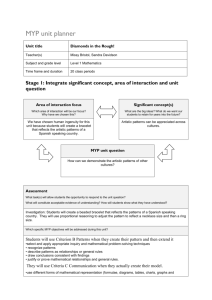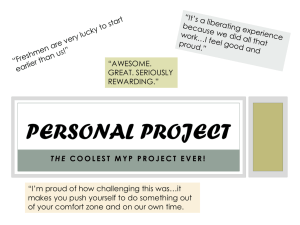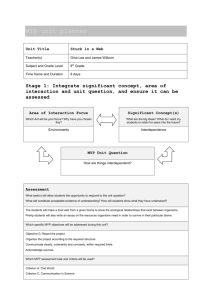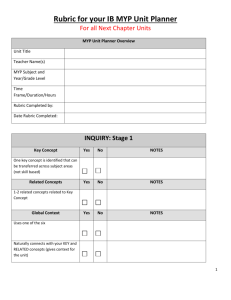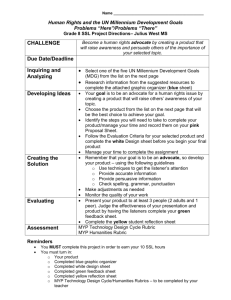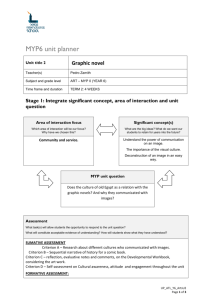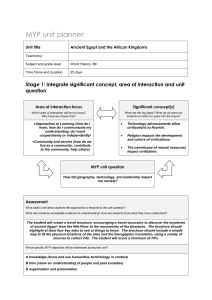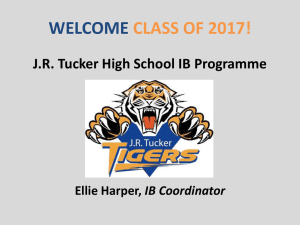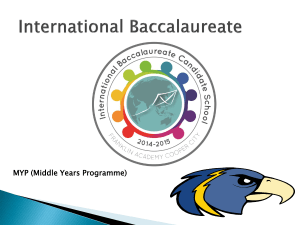Relations & Functions Unit Plan - 8th Grade Pre-Algebra
advertisement
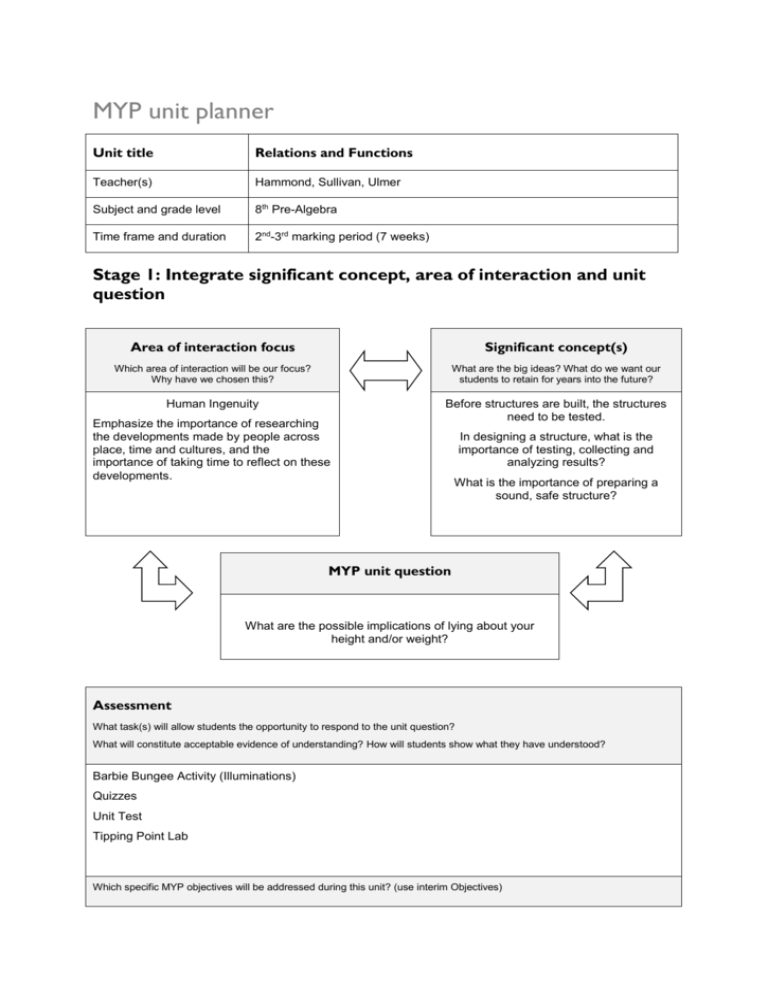
MYP unit planner Unit title Relations and Functions Teacher(s) Hammond, Sullivan, Ulmer Subject and grade level 8th Pre-Algebra Time frame and duration 2nd-3rd marking period (7 weeks) Stage 1: Integrate significant concept, area of interaction and unit question Area of interaction focus Significant concept(s) Which area of interaction will be our focus? Why have we chosen this? What are the big ideas? What do we want our students to retain for years into the future? Human Ingenuity Before structures are built, the structures need to be tested. Emphasize the importance of researching the developments made by people across place, time and cultures, and the importance of taking time to reflect on these developments. In designing a structure, what is the importance of testing, collecting and analyzing results? What is the importance of preparing a sound, safe structure? MYP unit question What are the possible implications of lying about your height and/or weight? Assessment What task(s) will allow students the opportunity to respond to the unit question? What will constitute acceptable evidence of understanding? How will students show what they have understood? Barbie Bungee Activity (Illuminations) Quizzes Unit Test Tipping Point Lab Which specific MYP objectives will be addressed during this unit? (use interim Objectives) Describe simple patterns as relationships or rules Explain simple mathematical relationships and general rules using logical arguments. Use different forms of mathematical representations Consider the reasonableness of results in the context of the problem and attempt to explain whether they make sense Know and demonstrate understanding of Algebra and Geometry Which MYP assessment criteria will be used? (attach rubric) Criterion A- Knowledge and Understanding Criterion D- Reflection Stage 2: Backward planning: from the assessment to the learning activities through inquiry Content What knowledge and/or skills (from the course overview) are going to be used to enable the student to respond to the unit question? What (if any) state, provincial, district, or local standards/skills are to be addressed? How can they be unpacked to develop the significant concept(s) for stage 1? 8-3.1 Translate among verbal, graphic, tabular, and algebraic representations of linear functions 8-3.5 Classify relationships between two variables in graphs, tables, and/or equations as either linear or nonlinear 8-3.6 Identify the coordinates of the z and y intercepts of a linear equation from a graph, equation, and/or table 8-3.7 Identify the slope of a linear equation from a graph, equation, and/or table. 8-4.2 Use ordered pairs, equations, intercepts, and intersections to locate points and lines in a coordinate plane. 8-6.1 Generalize the relationship between two sets of data by using scatterplots and lines of best fit. Approaches to learning How will this unit contribute to the overall development of subject-specific and general approaches to learning skills? Use real life problem to develop the appropriate bungee jumping cord for Barbie. Use pictures and graphs to determine slopes. Group activities Study guides/note cards Reflect on activities Learning experiences How will students know what is expected of them? Will they see examples, rubrics, templates? How will students acquire the knowledge and practise the skills required? How will they practise applying these? Do the students have enough prior knowledge? How will we know? Students will know what is expected of them through the use of rubrics, models and examples. Students will acquire the knowledge needed through direct instruction from the teacher. Notes and homework will be given for practice. The students should come to 8th grade with enough prior knowledge to begin the unit. Teaching strategies How will we use formative assessment to give students feedback during the unit? What different teaching methodologies will we employ? How are we differentiating teaching and learning for all? How have we made provision for those learning in a language other than their mother tongue? How have we considered those with special educational needs? Teacher will give formative assessments in the form of quizzes, tests, in-class hands-on activities, warm-ups and exit slips Teacher will give lectures and provide necessary notes, hands-on experiments, inquiry-based learning method Teacher will integrate algebra concepts versus just number concepts for higher order thinking, hands-on activities, models, a list of mathematical formulas and detailed descriptions/examples of project will be provided for struggling students. Teacher will work closely with special education and ESL teachers for input on how to meet the needs of students receiving special education services. Resources What resources are available to us? How will our classroom environment, local environment and/or the community be used to facilitate students’ experiences during the unit? Internet access Promethean Boards Compass Learning activities Graphing calculators Math tools (ruler, compass, protractor, etc.) Mathalicious website Mathematics Course 3 textbook (Holt McDougal) Kutasoftware.com Junior math bits website (subscription required). Activities will be completed in the classroom. Students will have access to all available resources and assistance from instructor when needed Planning for Learning Next, plan the learning experiences and instruction: Given the targeted understandings, other unit goals, and the assessment evidence identified, what will I teach each day of the unit? Week 1: Week 2: General review of coordinate plane and ordered pairs Define intercepts, x and y-axis Create input/output tables Slope Week 3: slope intercept form Determine intercepts from a graph and an equation Week 4: Linear /nonlinear (identifying from graph) Week 5: Explain the effects of changing m and b Analyzing slope as a rate of change- analyze y intercept as the starting point Week 6: Scatter plots Barbie Bungee Week 7: Unit review and test Ongoing reflections and evaluation In keeping an ongoing record, consider the following questions. There are further stimulus questions at the end of the “Planning for teaching and learning” section of MYP: From principles into practice. Students and teachers What did we find compelling? Were our disciplinary knowledge/skills challenged in any way? What inquiries arose during the learning? What, if any, extension activities arose? How did we reflect—both on the unit and on our own learning? Which attributes of the learner profile were encouraged through this unit? What opportunities were there for student-initiated action? Possible connections How successful was the collaboration with other teachers within my subject group and from other subject groups? What interdisciplinary understandings were or could be forged through collaboration with other subjects? Assessment Were students able to demonstrate their learning? How did the assessment tasks allow students to demonstrate the learning objectives identified for this unit? How did I make sure students were invited to achieve at all levels of the criteria descriptors? Are we prepared for the next stage? Data collection How did we decide on the data to collect? Was it useful? Figure 12 MYP unit planner
